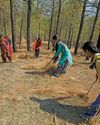
GEOGRAPHICAL INDICATION (GI) is a form of certification that recognises unique products based on their origin, which is often attributed to agro-climatic variations and traditional cultivation practices. This certification is also extended to non-agricultural products, such as handicrafts, based on human skills, materials and resources available in certain areas that make the product unique. Consumers prefer genuine products, and GI provides the assurance of authenticity while also promoting community development.
Trade reforms, legal protection and consumer acceptance are necessary to commercialise local products and gain premium prices in domestic and international markets. Empirical evidence from many developing and developed countries shows that GI helps economic enhancement at the producer’s level. But this is not true to the same extent in India, perhaps due to flaws in the GI registration system and market inefficiencies. Therefore, India’s journey of over two decades—the Geographical Indications of Goods (Registration and Protection) Rules was enacted in 1999—with GI has had limited outcomes and requires more popularisation to achieve its full economic potential. This article seeks to provide a perspective on the efforts and attention towards GI from national and international lenses and draw policymakers’ attention to this issue.
INDIA VIS A VIS WORLD
Denne historien er fra January 16, 2024-utgaven av Down To Earth.
Start din 7-dagers gratis prøveperiode på Magzter GOLD for å få tilgang til tusenvis av utvalgte premiumhistorier og 9000+ magasiner og aviser.
Allerede abonnent ? Logg på
Denne historien er fra January 16, 2024-utgaven av Down To Earth.
Start din 7-dagers gratis prøveperiode på Magzter GOLD for å få tilgang til tusenvis av utvalgte premiumhistorier og 9000+ magasiner og aviser.
Allerede abonnent? Logg på

THE CIRCULARITY ARGUMENT
A circular economy can help India achieve its developmental aspirations while following the low-carbon pathway. It will also help address the challenges of waste management, pollution and overexploitation of natural resources. Industries are already innovating to reuse high-volume wastes and have shown that the transition can usher in both environmental and financial windfalls

Banking on flawed drug voluntary licences
The Medicines Patent Pool is pushing for more VLs, but its bad deal with Novartis on a cancer drug shows the pitfalls

Lasting solutions
For the first time, the UN has recognised the role of indigenous communities in tackling aridity. A repository of traditional knowledge India has the wherewithal to lead the way

IMD at 150
India's journey into modern weather forecasting took a decisive turn 150 years ago with the establishment of India Meteorological Department during the British rule. The agency has come a long way since then, shaping the way the country predicts and responds to its diverse climate challenges

Every drop counts
In drought-prone Marathwada region, 14 villages have managed to counter water shortage by budgeting the resource

Threat to survival
Hollongapar Gibbon Sanctuary in Assam faces ecological challenges as railway electrification and hydrocarbon exploration endanger its fragile biodiversity

'Migration is going to be a battlefield'
AMITAV GHOSH is one of the foremost chroniclers of our times. His literary sojourn includes writings on topics that range from languages to climate change to human lives. His latest book, Wild Fictions, brings some of his works on these issues under one title. In a conversation with RAJAT GHAI, Ghosh shares his views on the future of human movement. Excerpts:

Face of future
California wildfires confirm forest fires are intensifying in a hotter world, emitting substantial amounts of greenhouse gases and reinforcing global warming

Friends of the forest
Residents of 30 villages in Uttarakhand establish a model for public participation in saving forests from wildfires

Climate-crazy playbook
Just hours after his second (and final) term began on January 20, US President Donald Trump unleashed 46 presidential actions. Several of these are centred on the US' climate commitments, energy transition, migration and trade policies, and are likely to have negative global implications